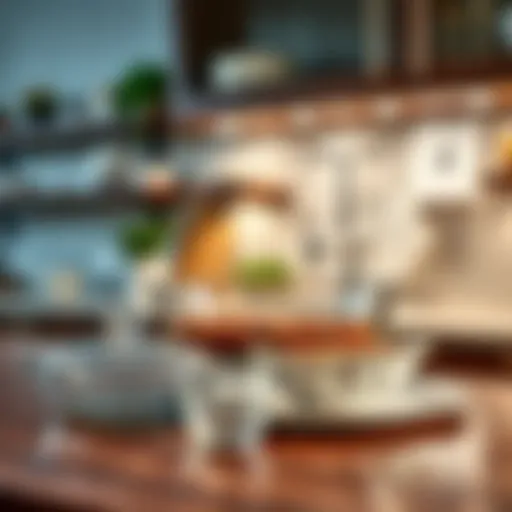Enhancing Kitchen Efficiency with Dish Mats
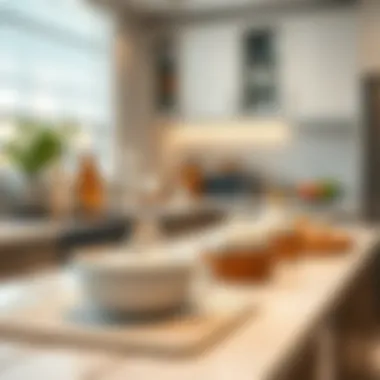

Intro
In today’s fast-paced world, keeping a tidy and organized kitchen is more important than ever. One often-overlooked tool in achieving this is the humble dish mat. While it may not make the cover of a design magazine, a dish mat plays an essential role in your kitchen’s functionality. Not only does it assist in draining dishes, but it also preserves the surface of your counters and helps maintain an orderly cooking environment. This article dives into the practical aspects of dish mats, from their construction and materials to how they can fit into your kitchen’s aesthetic.
Furniture Styles and Trends
Modern vs. Traditional: Understanding the Aesthetics
The design of your kitchen isn’t merely about large fixtures; it’s the little things too. Dish mats have evolved from simple cloth or rubber rectangles of the past to stylish and functional accessories that reflect modern design sensibilities. In modern kitchens, where sleek appliances dominate and minimalist decor reigns, choosing a dish mat that complements this aesthetic is crucial. Opt for mats in neutral colors or geometric patterns that enhance, rather than distract from the overall vibe of your space.
Conversely, in traditional kitchens, you may find dish mats made from natural fibers, such as cotton or bamboo, adorned with vintage prints. Using these can enhance the cozy and inviting feel often associated with traditional spaces. The key here is to select a dish mat that harmonizes with your kitchen's larger design narrative.
Color and Material Trends: What's In and What's Out
When it comes to colors and materials, certain trends have emerged. For modern kitchens, it's all about sophistication with a side of practicality. Here’s a quick rundown:
- Silicone Mats: Durable, easy to clean, and available in a range of chic colors. They’re gaining ground in contemporary kitchens.
- Microfiber Options: Soft to the touch and highly absorbent; they suit homes where aesthetics and function go hand-in-hand.
- Natural Fiber Mats: Though making a comeback in trendy spaces, these are often not as absorbent as their synthetic counterparts.
On the flip side, trends that are fading include:
- Plastic Mats: Once ubiquitous, their clunky designs and lack of absorbency are stepping back in favor of more stylish and effective options.
- Overly Busy Patterns: Simplicity is winning; kitchens are leaning towards minimalistic designs, and dish mats are no exception.
"Kitchen accessories should be as stylish as they are functional, adding value to the cooking space rather than cluttering it."
Care and Maintenance of Dish Mats
Tips for Prolonging the Life of Your Dish Mat
Even the best dish mats require some TLC to keep them in working condition. Here are a few guidelines to ensure longevity:
- Regular Washing: For fabric mats, a machine wash on a gentle cycle will keep them looking fresh.
- Avoiding Heat: Remove any hot items from mats immediately to prevent damage.
- Drying Properly: Always air dry mats to prevent warping or other damages.
DIY Repair Hacks for Common Dish Mat Issues
It's not uncommon for dish mats to show signs of wear over time. Here are some quick fixes:
- Fraying Edges: A little clear fabric glue can do wonders to hold things together.
- Stains: For stubborn stains, a mixture of baking soda and water can help scrub those pesky marks away.
By integrating dish mats effectively and maintaining them well, they can transform into a fundamental element of a modern kitchen, contributing both functionally and aesthetically to your space.
Prologue to Dish Mats
In today's fast-paced life, every little element in our kitchens carries weight, and dish mats are no exception. They serve not only as a means to drain wet dishes but also as a shield for kitchen surfaces and an aid for maintaining order. Understanding their practical role can make a significant difference in kitchen efficiency and cleanliness.
Dish mats are designed to absorb moisture while providing a soft place for dishes to rest after hand washing or before putting them away. Think of them as the unsung heroes in the realm of kitchen accessories. Specifically, they cater to various needs—from protecting countertops from scratches to offering a quick-drying surface that helps keep bacteria at bay.
One key benefit of dish mats is their adaptability to different kitchen styles. Whether you have a minimalist modern space or a cozy farmhouse aesthetic, there exists a dish mat that can seamlessly integrate with your design. Such versatility makes them essential not just for functionality but also for enhancing the overall visual appeal of the space.
When considering the overall kitchen experience, neglecting dish mats can result in water damage, pesky stains, and a cluttered environment. An efficient dish mat can significantly reduce the time and effort spent on both dish cleaning and kitchen maintenance.
As we journey through the various functionalities and the history of dish mats, it becomes evident how they've transitioned into a staple item, showcasing not only practicality but also an evolving design that aligns with our modern sensibilities.
Functionality of Dish Mats
Dish mats perform several critical functions that elevate them from mere towels or pads to essential kitchen tools. Their main purpose is to collect drainage from clean dishes, allowing water to evaporate without pooling on countertops. This helps with:
- Preventing Water Damage: An efficient mat absorbs excess water, safeguarding surfaces against long-term damage from moisture.
- Offering Insulation: Dish mats can provide a soft cushion, protecting delicate dishware from accidental chipping, which can be an everyday hazard in busy kitchens.
- Enhancing Cleanliness: Using a dish mat contributes to a cleaner kitchen environment by preventing drips and splatters that are common with air-drying dishes directly on countertops.
- Simplifying Organization: They offer designated space for drying dishes, making it easier to maintain order in the kitchen.
In essence, the functionality of dish mats extends beyond simply drying dishes; they create a more manageable and efficient workspace.
The Evolution of Kitchen Drainage Solutions
Historically, kitchens have utilized various solutions to manage excess water and enhance drying efficiencies. In the early days, people relied on simple cloths or towels laid across surfaces to absorb unwanted moisture. While this method served a purpose, it often led to more mess and potential bacterial growth.
As time progressed, innovative materials and designs emerged. Dish mats began to appear, made from different materials designed with drainage in mind. For example:
- Rubber Mats: Gained popularity due to their water-resistant properties, providing a robust barrier against pooling.
- Microfiber Mats: Known for their absorbent nature, these mats can hold significant amounts of water while being quick-drying.
- Cotton and Bamboo Varieties: Offer eco-friendly options that not only dry dishes but appeal to the environmentally conscious consumer.
The shift from basic towels to specialized dish mats illustrates the kitchen's ongoing growth and changing needs. More than just a trend, this evolution points to consumers' desire for efficiency, longevity, and aesthetic appeal in their kitchen tools.
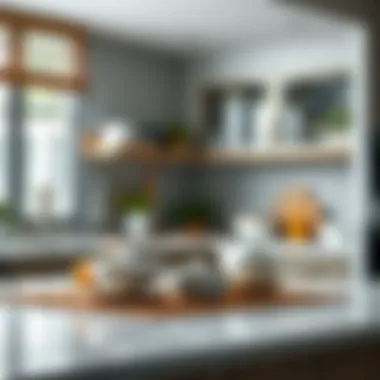

"Modern dish mats embody a fusion of style and practicality, representing an important step towards smarter kitchen solutions."
This exploration of dish mats highlights how they've become a necessary fixture in kitchens today, combining ornamental value with decisive advantages.
Types of Dish Mats
Understanding the various types of dish mats available is crucial for selecting the right one to meet the needs of your kitchen. Each type serves a unique purpose, boasting distinct materials and construction qualities that can improve functionality and efficiency. The selection can impact everything from drying speed to aesthetics, which are essential considerations for any modern kitchen. Let's explore the different varieties of dish mats to find the right fit for your kitchen environment.
Silicone Dish Mats
Silicone dish mats are a popular choice among homeowners and kitchen enthusiasts alike. Their standout feature is flexibility; they can be rolled up or laid flat, making storage a breeze. Silicone's non-slip surface prevents dishes from sliding off, giving you peace of mind. One of the more appealing aspects of silicone is its resistance to heat and stains. This heat resistance means that you can safely place hot pots and pans on them without worrying about damage.
Moreover, cleaning silicone mats is child’s play. A quick rinse or wipe-down is often sufficient, as they are dishwasher safe, providing ease of maintenance.
However, keeping an eye on a mat’s thickness can help ensure it stays effective. Thicker mats generally provide better cushioning and drainage, potentially prolonging their lifespan.
Microfiber Dish Mats
Microfiber dish mats present an interesting blend of absorbency and quick-drying capabilities, making them a favorite in many kitchens. One of the paramount benefits of microfiber is its ability to soak up water rapidly, preventing puddles from forming on your counter.
These mats typically feature a plush texture, offering a soft landing for fragile dishes, such as glassware or ceramics. The fibers of the mat also allow for effective airflow, ensuring that moisture evaporates rather than being trapped under the dishes.
One downside could be their susceptibility to staining or odors if not washed properly. Regular machine washing helps in maintaining hygiene and prolonging their use in your kitchen, so keep that in mind when investing.
Cotton Dish Mats
Cotton dish mats are perhaps the most traditional option, bringing a natural touch to modern kitchens. Made from 100% cotton fabric, these mats are highly absorbent and excel in soaking up water and drying dishes quickly. This natural material also allows for breathability, which is essential for minimizing mold or mildew growth.
However, they can be a little cumbersome when it comes to cleaning, as many cotton mats require machine washing and may lose their form over time. Choose a cotton mat with a protective layer to enhance durability and maintain its shape.
The design options with cotton are vast, allowing for customization and a real splash of personality in your kitchen decor. With a range of colors and patterns available, they can seamlessly integrate into your existing designs.
Antimicrobial Dish Mats
Antimicrobial dish mats are specifically designed to tackle issues of hygiene in the kitchen. Coated with special agents that prevent the growth of bacteria and mold, these mats can be invaluable for those particularly keen on cleanliness and sanitation. The idea is to ensure that the surface remains safe for drying dishes and for your general health.
These mats still maintain all the advantages usually found in other materials—such as absorbency and quick-drying capabilities. Many homeowners will find that investing in an antimicrobial mat not only provides functional benefits but also peace of mind.
Keep in mind that while these mats can be pricier than traditional options, the long-term benefits in terms of health and maintenance can certainly justify the cost. This could be a great choice if you frequently engage in cooking and entertaining.
"Selecting the right dish mat can go a long way toward creating an organized kitchen space while addressing practical needs such as drying and maintenance."
Materials and Construction
Understanding the materials and construction of dish mats is key in making informed choices when outfitting your kitchen. The effectiveness, durability, and safety of a dish mat depend largely on these factors. Each material brings its own strengths and weaknesses, making it essential to assess what you truly need before purchase.
Overview of Material Choices
Dish mats come in various materials, each designed to serve different functions in the kitchen. Common choices include:
- Silicone: Known for its flexibility and heat resistance, silicone dish mats are a popular choice. They can absorb excess water while being quick to dry. Plus, silicone mats are often dishwasher safe, making cleaning a breeze.
- Microfiber: This material excels at soaking up water efficiently. It's soft and gentle on dishes, minimizing the chances of scratches. Microfiber also tends to dry faster than cotton, reducing the risk of mold and mildew.
- Cotton: A classic option, cotton mats are generally very absorbent. They come in various textures and patterns, providing aesthetic appeal. However, they may require more frequent washing to keep them fresh.
- Antimicrobial: With rising focus on hygiene, antimicrobial mats are crafted with materials that resist bacteria and mold. These are particularly useful for families with young kids or when food safety is a priority.
Durability and Longevity
When investing in dish mats, durability cannot be overlooked. Materials like silicone and antimicrobial options often outlast their fabric counterparts. Here are some points to consider regarding durability:
- Material Resistance: Silicone mats are not only heat resistant but also less prone to wear and tear compared to cotton or microfiber. They can withstand high temperatures without warping, making them versatile.
- Cleaning Ease: The longevity of a dish mat is also tied to how easy it is to clean. Microfiber mats can last longer if they are washed correctly; machine-washable options usually fare better than those that require hand-washing.
- Wear and Tear Indicators: Over time, watch for signs such as fraying edges or discoloration. A quick inspection can save you from potential kitchen hazards down the line.
Eco-Friendly Options
In a world increasingly focused on sustainability, eco-friendly dish mats are becoming more prominent. Here are some eco-conscious selections:
- Recycled Materials: Many brands offer dish mats made from recycled fibers. These options provide the durability needed while minimizing waste, perfect for environmentally conscious consumers.
- Biodegradable Options: Some manufacturers are opting for materials that are fully biodegradable. These products break down naturally over time, eliminating environmental impact.
- Natural Fibers: Cotton and bamboo mats, aside from being aesthetically pleasing, often come from renewable sources. They can be a wonderful choice for those looking for a greener kitchen solution.
If you prioritize sustainability, look for certifications or labels indicating eco-friendly production methods.
By understanding the materials and construction of dish mats, kitchen enthusiasts can choose wisely, ensuring that their dish mats not only serve their functional purposes but also align with their values and lifestyle.
Benefits of Using Dish Mats
Understanding the benefits of using dish mats in modern kitchens goes beyond mere convenience. Dish mats are integral to the efficient functioning of kitchen spaces, offering practical solutions that enhance both utility and aesthetics. As people spend more time in their kitchens, the need for supportive tools becomes apparent. Here, we’ll break down more specific benefits, all of which contribute to a seamless kitchen experience.
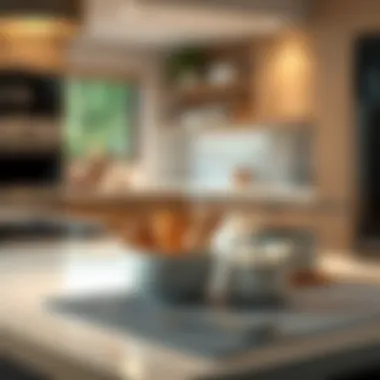

Surface Protection
One significant advantage of dish mats is their capacity to protect countertops and tables. Placing wet dishes directly on wood or granite can cause lasting damage, such as scratches, stains, or even warping. A dish mat serves as a barrier, absorbing moisture and preventing these kitchen surfaces from deteriorating.
- Material Matters: Different materials offer varying levels of protection. For instance, silicone mats repel water and are easy to clean, while cotton mats can provide soft cushioning against delicate dishes. Each choice comes with distinct benefits.
- Prolonged Lifespan: Using a dish mat can be seen as a proactive measure to extend the life and beauty of kitchen surfaces, avoiding costly repairs or replacements down the line.
"An ounce of prevention is worth a pound of cure."
This age-old adage rings true in the kitchen, highlighting the importance of protecting surfaces with a simple mat.
Water Drainage Efficiency
Efficient drainage is essential for any kitchen setup. Dish mats are specifically designed to facilitate the quick evaporation of water, promoting faster drying of washed dishes. Unlike traditional towels that may retain moisture, a quality dish mat allows liquid to flow away from dishes.
- Design Matters: Many mats are crafted with drainage channels or absorbent cores that wick away moisture efficiently. This helps to prevent water pooling around your items, which could foster mold or mildew.
- Optimized Drying Space: A dish mat offers a dedicated area for drying dishes, pots, and utensils, freeing up counter space for preparation or other tasks.
Organizational Impact
The use of dish mats extends beyond simple function; they also contribute to an organized kitchen environment. A well-placed dish mat can help delineate drying areas, keeping your dishes arranged neatly instead of scattered across the countertop.
- Clutter Reduction: With an effective dish mat, homeowners can manage dish drying with ease, leading to reduced clutter and a visually pleasing space.
- Multi-Use Hub: Many mats double as drying zones for washing fruits and vegetables, making them versatile assets in any kitchen.
Aesthetic Contributions
Finally, dish mats can enhance the overall aesthetic of a kitchen. They come in various colors, designs, and materials, allowing users to select options that align perfectly with their decor choices.
- Style Complement: A beautifully designed dish mat can serve as a subtle accent while still being functional. Whether you’re using a bright silicone mat or a subtle, patterned microfiber one, style can boost the personality of a kitchen.
- Current Trends: Keeping in touch with current design trends, many manufacturers now offer mats that match popular kitchen themes, such as farmhouse chic or sleek modern aesthetics.
Choosing the Right Dish Mat
Selecting the ideal dish mat can significantly impact your kitchen’s functionality and style. A dish mat isn't just a mere accessory; it's an essential tool that enhances efficiency, protects surfaces, and contributes to an organized culinary space. Understanding what to look for when choosing a dish mat will help you not only keep your kitchen tidy but also align with the overall aesthetics of the room.
Factors to Consider
When it's time to pop into the store or browse online, several factors should weigh into your decision about which dish mat to bring home. Firstly, consider the material. Dish mats come in a variety of fabrics, each with their own virtues. Silicone mats are quite popular due to their heat resistance and durability. Microfiber, on the other hand, shines in absorption and softness.
Then, there's thickness. A thicker mat absorbs water better and can provide extra cushioning for fragile dishes. Next, use* can not go unnoticed — if your kitchen is frequently bustling with activity, a mat that dries quickly and resists odors is crucial.
Lastly, don’t forget about care and maintenance. Some mats require machine washing, while others may just need a wipe-down. Choosing one that's easy to clean can save you a heap of time in the long run.
Size and Fit
The size of your dish mat matters more than you might assume. A mat that’s too small won’t catch all the drips and spills, while a mat that’s too large can hinder movement in a busy kitchen. To determine the right size, measure the area adjacent to your sink where the mat will lie. Common sizes range from 18x24 inches to 21x35 inches, but don’t hesitate to pick a custom size if necessary.
It's also beneficial to note how many dishes you typically wash at once. If you regularly handle large loads, consider a bigger mat to accommodate all those dishes. On the flip side, if you prefer a minimalist approach in a smaller kitchen, a standard size may suffice.
Style and Design Compatibility
A dish mat can either stand out as a statement piece or blend in seamlessly with your existing kitchen design. When selecting a mat, keep an eye out for color and pattern that aligns with your kitchen’s décor. Do you favor bold colors or subtle hues? Patterns, too, can speak volumes and often add a layer of depth to your kitchen. Perhaps floral designs or geometric shapes resonate with you — whatever your taste, the mat should reflect that.
Also, consider material finishes. For country-style kitchens, an organic cotton dish mat might fit like a glove. In contrast, a sleek silicone mat might complement a modern kitchen’s streamlined aesthetic.
Aligning your dish mat with your kitchen’s overall style not only enhances visual appeal but also provides a cohesive look and feel that can elevate your space into something truly inviting.
"Selecting the right dish mat encompasses more than just practicality; it harmonizes functionality with aesthetics, ensuring your kitchen reflects personal style while serving its purpose."
In summary, when it comes to choosing the right dish mat, a little forethought can go a long way. By considering factors like material, size, and design compatibility, you can find a mat that not only meets your daily needs but also becomes a delightful component of your kitchen's atmosphere.
Care and Maintenance of Dish Mats
Maintaining dish mats is not just about keeping them clean; it’s essential for maximizing their lifespan and efficiency in a modern kitchen. Dish mats endure a lot—from drying wet dishes to absorbing spills—and regular care ensures they continue to function effectively while also looking good. Not giving your dish mat the attention it deserves can lead to unpleasant odors, stains, or deterioration. A little maintenance can go a long way, ensuring that these kitchen essentials remain both practical and aesthetically pleasing.
Cleaning Instructions for Various Materials
When it comes to cleaning, the material of your dish mat dictates the best approach. Here’s a breakdown of how to care for each type:
- Silicone Dish Mats: These mats are generally easy to clean. Simply rinse them under warm water or pop them in the dishwasher. They are resilient, able to withstand high temperatures, and won’t absorb odors or stains.
- Microfiber Dish Mats: The soft fibers are great for absorbing water, but they can also trap particles. To clean, toss them in the washing machine on a gentle cycle. Use mild detergent and line dry or tumble dry on low heat.
- Cotton Dish Mats: Cotton mats may require a bit more attention. Handwashing is a good option, but machine washing is fine too. Wash in cold water with a gentle detergent, then air dry to maintain their shape and absorbency.
- Antimicrobial Dish Mats: These are often treated to resist odors and stains. Warm water and soap usually do the trick. Just avoid bleach or harsh chemicals that can ruin the antimicrobial properties.
"Regular maintenance not only extends the life of your dish mat but also keeps your kitchen clean and welcoming."
Storage Tips
Once cleaned, proper storage of your dish mat is crucial. Here’s how to do it right:
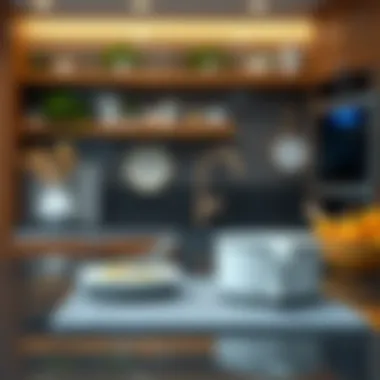

- Dry Completely: Always ensure that your dish mat is completely dry before folding or storing it. Moisture can lead to mold or mildew, which negates the very purpose of using a mat.
- Flat Storage: If space allows, store your dish mats flat. This prevents creases and helps retain their original shape. If they must be rolled, do so loosely to avoid creasing.
- Avoid Heavy Items: Don’t stack heavy cookware or dishes on top of your dish mat while it’s stored. This can lead to twisting and deformation over time.
- Designated Space: Create a specific spot in your kitchen for your dish mats. This way, they’re easily accessible when needed and less likely to get misplaced or damaged.
By prioritizing proper care and maintenance of your dish mats, you not only enhance their functionality but also contribute to a more organized and efficient kitchen environment. In the long run, these small efforts reflect on the overall cleanliness and preparedness of your kitchen, making it a better space for culinary adventures.
Innovations in Dish Mat Design
In recent times, advancements in kitchen accessories have led to the evolution of dish mat designs, enhancing their utility in modern kitchens. Innovations in this space are not merely about aesthetic updates; they aim to address practical challenges faced by homeowners. The integration of technology with traditional designs offers numerous functionalities that greatly benefit daily kitchen tasks.
Smart Dish Mats
Smart dish mats represent a significant leap in kitchen technology, merging convenience with function. These mats often come equipped with sensors that detect moisture levels and even temperature. When the mat senses a certain level of humidity, some models can activate a fan or heating element to expedite drying.
- Benefits:
- Efficiency: This proactive approach reduces drying time significantly, ensuring that dishes are ready to be put away faster.
- Cleanliness: Many smart mats are designed with antimicrobial coatings, keeping your kitchen healthier and reducing germs that thrive in damp environments.
- User-friendly: Some models connect to smartphone app, allowing users to track drying conditions even when they're not at home. This feature may not be essential for everyone, but for those keen on tech, it adds convenience.
Despite these benefits, consumers should consider aspects like battery life and compatibility with their existing kitchen appliances before diving into the purchase of a smart dish mat.
Multi-functional Mats
Multi-functional mats have quickly gained traction, focusing on versatility and space efficiency in kitchens that often lack sufficient room. These mats may not only function as drying surfaces for dishes but can also serve multiple purposes, including preparation surfaces or even as cutting boards.
- Key features of multi-functional mats:
- Convertible Use: Designs that easily transform from a dish-drying mat to a roll-up silicone cutting board are particularly favored in smaller kitchens.
- Storage Efficiency: Many of these mats can be rolled up or folded, making them ideal for stowing away when not in use. This functionality is especially appealing for those living in high-density urban settings where every inch of counter space counts.
- Sustainability: A growing number of multi-functional mats are crafted from eco-conscious materials, allowing homeowners to maintain an environmentally friendly kitchen without sacrificing ergonomics.
In essence, innovations in dish mat design have created solutions that cater to both practical needs and contemporary lifestyle demands. The integration of technology, along with versatility in function, not only elevates the usefulness of dish mats but how they blend seamlessly into modern culinary environments.
"Innovations in dish mat design not only address practical kitchen challenges but also reflect a shift towards smarter, more efficient cooking spaces."
Stay informed about emerging trends by checking out sites like Britannica or community discussions on platforms like Reddit. For ongoing kitchen design trends, visit Houzz or Pinterest for visual inspiration.
Dish Mats in Interior Design
When it comes to modern kitchens, every little detail contributes to an overall aesthetic experience. Dish mats often get overlooked in this equation, but they play an essential role in both functionality and design. Not just a simple tool for drying dishes, they can enhance the visual appeal of a kitchen, making them an important component in interior design.
Incorporating dish mats into kitchen aesthetics can influence the atmosphere of the space significantly. For starters, dish mats can serve as a subtle but impactful statement piece, reflecting personal style. Whether you lean towards a minimalist approach with solid colors or prefer a vivid pattern that adds some flair, the right dish mat can complement your design theme. Think of them as color anchors, tying together various elements in your kitchen.
On top of that, a well-chosen dish mat can also demonstrate a homeowner's attention to detail. When guests stroll into your kitchen and notice the harmonious blend of colors and textures, it speaks volumes about the care you put into creating the environment. This doesn’t just elevate your kitchen but also creates a sense of cohesion. A mismatched dish mat in an otherwise coordinated kitchen can feel like a sore thumb. Hence, selecting dish mats that resonate with your design aesthetic fosters a seamless visual narrative that tells your unique story.
Incorporation in Kitchen Aesthetics
Integrating dish mats into kitchen decor isn't just about choosing a nice fabric or color—it’s an art in itself. Consider how the dish mat interacts with its setting. In a contemporary kitchen adorned with stainless steel appliances and sleek cabinetry, opting for a glossy silicone mat might enhance the modern vibe. Conversely, in a rustic kitchen with wooden surfaces, a cotton mat with earthy tones or floral patterns can enrich the warm ambiance.
Moreover, the placement of a dish mat can also influence the flow of a kitchen. A mat laid down near the sink not only serves a purpose but becomes part of the functional yet aesthetic landscape. Here are a few tips to make the most of dish mats:
- Layering Textures: Consider using dish mats with different textures to create depth in your culinary space.
- Matching with Accents: Select mats that align with other kitchen accents, like curtains or backsplash tiles.
- Seasonal Switches: Don't hesitate to switch your dish mat seasonally, introducing new colors or designs that breathe fresh life into your kitchen.
Color and Pattern Trends
The world of design is ever-evolving, and dish mats are no exception. As trends come and go, homeowners and designers alike are becoming astute at adopting patterns and colors that reflect current styles while still resonating with personal flair. For 2023, expect a rise in vibrant, bold colors that contrast or complement cabinetry. Deep greens, warm terracotta, and lively yellows can evoke a sense of warmth and vibrancy.
Patterns, too, are making waves—with geometric designs being all the rage. They add a modern twist and can easily engage the eye, ensuring your mat does more than just lie flat on the counter.
"Patterns like chevrons or botanical prints can infuse life into a space that might feel too sterile or uniform, making the kitchen feel dynamic and inviting."
While minimalism remains a staple in design, there is a distinct shift towards maximalism, where layering and mixing patterns create a playful yet cohesive kitchen experience. Discerning homeowners are blending pattern types—such as pairing a striped mat with polka-dotted dish towels—to craft a unique, visually engaging environment.
In summary, while dish mats are often pigeonholed into the realm of practicality, their potential in interior design cannot be overstated. They can uplift aesthetics, foster a cohesive feel, and even become trendsetters in their own right, proving that even small items can make a big impact in the kitchen.
End
In the grand scheme of culinary crafting, the humble dish mat plays a surprisingly pivotal role in modern kitchens. It acts not only as a practical tool for drainage but also as a significant element in enhancing the efficiency and aesthetics of kitchen spaces. As we wrap up this exploration, it’s essential to reflect on several key aspects that underpin the importance and value of dish mats.
Summation of Key Points
- Functionality: At its core, a dish mat facilitates effective water drainage, ensuring that clean dishes dry properly without pooling water that can damage surfaces.
- Versatility: Dish mats come in a variety of materials and styles, from silicone to microfiber, catering to different needs and preferences.
- Surface Protection: These mats prevent scratches and stains on countertops, significantly prolonging the life and appearance of kitchen surfaces.
- Organizational Aid: By providing a dedicated spot for drying dishes, dish mats help keep kitchen spaces tidy and organized.
- Aesthetic Value: With numerous colors and designs available, dish mats can enhance the overall look of a kitchen, making them both functional and visually appealing.
By weaving these factors into the daily routine, homeowners can optimize their kitchen experience and maintain a space that is not just functional but pleasing.
Future Outlook on Dish Mats
Looking ahead, the role of dish mats in kitchens is expected to evolve further. With the continuous advancements in materials, consumers may soon witness more innovative designs that integrate smart technology. Ideas such as mats equipped with sensors to indicate moisture levels or mats that incorporate antibacterial features hold promise for enhancing hygiene and efficiency.
Furthermore, as sustainability trends continue to rise, we may see an influx of eco-friendly dish mats constructed from recycled or biodegradable materials. This could appeal particularly to environmentally conscious consumers who seek to minimize their ecological footprint.
"The future of kitchen accessories, including dish mats, is leaning towards smarter, more sustainable designs that cater to the modern homeowner's needs."









